Cinacalcet hydrochloride
Synonym(s):AMG 073 hydrochloride;KRN 1493 hydrochloride;N-[1-(R)-(-)-(1-naphthyl)ethyl]-3-[3(trifluoromethyl)phenyl]-1-aminopropane hydrochloride;NPS 1493 hydrochloride
- CAS NO.:364782-34-3
- Empirical Formula: C22H23ClF3N
- Molecular Weight: 393.88
- MDL number: MFCD08067750
- EINECS: 620-490-5
- SAFETY DATA SHEET (SDS)
- Update Date: 2025-12-23 13:58:55

What is Cinacalcet hydrochloride?
Description
Cinacalcet is the first entry in a new class of therapeutic agents called the calcimimetics. It was launched as an oral treatment for secondary hyperparathyroidism (SHPT) in patients with chronic kidney disease on dialysis and for hypercalcemia in patients with parathyroid carcinoma. SHPT is associated with increased parathyroid hormone (PTH) secretion, which is triggered by low serum levels of calcium resulting from the failure of the kidney to clear phosphorous from the body and its inability to produce sufficient quantities of vitamin D. The consequences of increased PTH include stimulation of osteoclastic activity, cortical bone resorption and marrow fibrosis. PTH secretion is primarily regulated by the calcium-sensing receptor (CaR), which is located on the surface of the chief cell of the parathyroid gland. Calcimimetics bind to CaR and increase the sensitivity of CaR to extracellular calcium, thereby enabling its activation at subnormal levels of serum calcium. As a result, in the presence of these agents, the low levels of endogenous calcium in patients with renal failure are able to exert a suppressive effect on PTH secretion. Parathyroid carcinoma is also associated with elevated PTH levels, which are driven by autonomous parathyroid gland activity and subsequently lead to hypercalcemia. Although surgical resection is the primary therapy for treating hypercalcemia in parathyroid carcinoma patients, calcimimetics offer a nonsurgical alternative for patients with failed parathyroidectomy, metastatic parathyroid carcinoma, or high surgical risk. The recommended dosage of cinacalcet for the treatment of SHPT in chronic kidney disease is 30mg once daily at start and subsequent titration to 60, 90, 120 or 180 mg once daily. The dosage for the treatment of hypercalcemia in patients with parathyroid carcinoma is 30 mg twice daily at start and subsequent titration to 60 or 90 mg twice daily, or 90mg three or four times daily as necessary to normalize serum calcium level. After oral administration of cinacalcet, maximum plasma concentration is achieved in approximately 2 to 6 hours. It has a terminal half-life of 30 to 40 hours and steady-state drug levels are reached within 7 days. Cinacalcet has a high volume of distribution (1000 L) and high protein binding (93%–97%). It is extensively metabolized in the liver, mainly by CYP3A4, CYP2D6 and CYP1A2. The primary routes of elimination are in the urine (80%) and in the feces (15%). In Phase III clinical trials involving 1136 patients with SHPT, administration of cinacalcet at 30–180 mg/day doses for 6 months produced 38–48% decrease in intact PTH. Overall, 64% of patients given cinacalcet achieved at least a 30% reduction in PTH, versus 11% of placebo patients. Calcium-phosphorous product was reduced 14% by the active treatment and did not change in the placebo group. In a much smaller clinical study involving 21 hypercalcemic patients with parathyroid carcinoma, administration of 60–360 mg/day doses of cinacalcet resulted in 71% of patients achieving a target reduction of ≥1 mg/dL in serum calcium. The most common adverse events in these trials were nausea and vomiting. In vitro, cinacalcet is a strong inhibitor of CYP2D6; therefore, dose adjustments may be required when coadministered with medications that are predominantly metabolized by CYP2D6 and have a narrow therapeutic index (e.g. flecainide, vinblastine, thioridazine and most tricyclic antidepressants). Cinacalcet is prepared in a two-step synthesis starting from 3-[3-(trifluoromethyl)phenyl]propionaldehyde, by first condensing with (R)-(1-naphthyl)ethylamine to form the corresponding imine and subsequent reduction of the imine with sodium cyanoborohydride.
Chemical properties
Off-White to Tan Solid
Originator
NPS pharmaceuticals (US)
The Uses of Cinacalcet hydrochloride
Cinacalcet hydrochloride can be used in clinical trial in secondary hyperparathyroidism.
The Uses of Cinacalcet hydrochloride
Cinacalcet hydrochloride is an orally active, allosteric agonist of Ca receptor (CaR), used for cardiovascular disease treatment.
What are the applications of Application
Cinacalcet Hydrochloride is an allosteric activator of CaSR
Definition
ChEBI: A hydrochloride derived from equimolar amounts of cinacalcet and hydrogen chloride.
brand name
Sensipar (Amgen).
Biological Activity
Cinacalcet hydrochloride is a calcium-sensing receptor (CaSR) allosteric agonist. Activates CaSR signaling in cellular proliferation and phosphatidylinositol (PI) hydrolysis assays. Reduces serum parathyroid hormone levels in rats. Also potent CYP2D2 inhibitor (IC50 = 87 nM) and L-type calcium channel blocker. Orally bioavailable.
Mechanism of action
Cinacalcet hydrochloride directly regulates a major regulator of parathyroid hormone (PTH) secretion, the calcium-sensitive receptor (CaR) on parathyroid master cells. Cinacalcet hydrochloride reduces circulating levels of PTH by increasing the sensitivity of the CaR to extracellular calcium.
Side Effects
Cinacalcet hydrochloride was generally well tolerated in clinical trials. The severity of most treatment-emergent adverse events was mild to moderate. Common side effects of Cinacalcet hydrochloride include: nausea, vomiting, or unusual tiredness. Severe may also include low calcium levels in the blood, numbness/tingling of the skin; severe muscle cramps, seizures, and abnormal heartbeat.
Synthesis
General syntheses of this class of compounds have been published, however, the specific synthesis of cinacalcet (III) has not been available to date. The synthesis of cinacalcet, based on a patented procedure, is depicted in Scheme 3. A mixture of 1-acetonaphthone (21), 3-trifluoromethyl-1-propylamine (22) and titanium (IV) isopropoxide were stirred at rt to form the enamine intermediate which was reduced with methanolic sodium cyanoborohydride at rt to give corresponding racemic a-methyl amine (23). Compound 23 was resolved and then treated with HCl etherate to give cinacalcet hydrochloride (III) as a white solid.

Storage
Store at -20°C
References
[1] ureña p1, frazão jm. calcimimetic agents: review and perspectives. kidney int suppl. 2003 jun;(85):s91-6.
[2] colloton m1, shatzen e, wiemann b, starnes c, scully s, henley c, martin d.cinacalcet attenuates hypercalcemia observed in mice bearing either rice h-500 leydig cell or c26-dct colon tumors. eur j pharmacol. 2013 jul 15;712(1-3):8-15.
Properties of Cinacalcet hydrochloride
| Melting point: | 175-177°C |
| storage temp. | Inert atmosphere,2-8°C |
| solubility | insoluble in H2O; ≥17.85 mg/mL in DMSO; ≥56 mg/mL in EtOH |
| form | solid |
| color | White to off-white |
| InChI | InChI=1/C22H22F3N.ClH/c1-16(20-13-5-10-18-9-2-3-12-21(18)20)26-14-6-8-17-7-4-11-19(15-17)22(23,24)25;/h2-5,7,9-13,15-16,26H,6,8,14H2,1H3;1H/t16-;/s3 |
| CAS DataBase Reference | 364782-34-3(CAS DataBase Reference) |
Safety information for Cinacalcet hydrochloride
| Signal word | Danger |
| Pictogram(s) |
 Corrosion Corrosives GHS05  Exclamation Mark Irritant GHS07  Health Hazard GHS08 |
| GHS Hazard Statements |
H302:Acute toxicity,oral H314:Skin corrosion/irritation H317:Sensitisation, Skin H373:Specific target organ toxicity, repeated exposure H413:Hazardous to the aquatic environment, long-term hazard |
| Precautionary Statement Codes |
P260:Do not breathe dust/fume/gas/mist/vapours/spray. P273:Avoid release to the environment. P280:Wear protective gloves/protective clothing/eye protection/face protection. P314:Get medical advice/attention if you feel unwell. P303+P361+P353:IF ON SKIN (or hair): Remove/Take off Immediately all contaminated clothing. Rinse SKIN with water/shower. P305+P351+P338:IF IN EYES: Rinse cautiously with water for several minutes. Remove contact lenses, if present and easy to do. Continuerinsing. |
Computed Descriptors for Cinacalcet hydrochloride
| InChIKey | QANQWUQOEJZMLL-LSQUZMQTNA-N |
| SMILES | C12C=CC=CC1=CC=CC=2[C@@H](C)NCCCC1=CC=CC(C(F)(F)F)=C1.Cl |&1:10,r| |
Cinacalcet hydrochloride manufacturer
DR ACHARYA LABORATORIES PVT LTD
Aruvi Labs
New Products
4,4-Difluoropiperidine hydrochloride tert-butyl 9-methoxy-3-azaspiro[5.5]undecane-3-carboxylate Indole Methyl Resin N-Isopropylurea N,N-Dicyclohexylcarbodiimide(DCC) MELDRUMS ACID 5-METHYLISOXAZOLE-4-CARBOXYLIC ACID Magnessium Bis glycinate Zinc ascorbate 1-bromo-2-butyne 2-acetamidophenol 9(10H)-anthracenone Erythrosin B, 4-Piperidinopiperidine 2-((4-morpholinophenylamino) (methylthio) methylene) malononitrile 2,4-dihydroxybenzaldehyde 3-(4-morpholinophenylamino)-5-amino-1H-pyrazole-4-carbonitrile Methyl 2-methylquinoline-6-carboxylate 2,6-dichloro-4-nitropyridine 4-Bromo-2-chlorobenzonitrile 2-(benzylamino)acetic acid hydrochloride 4-(tert-Butoxycarbonylamino)but- 2-ynoic acid 3,4-dihydro-2H-benzo[b][1,4]dioxepine 1-Phenyl-1-cycloprppanecarboxylicacidRelated products of tetrahydrofuran
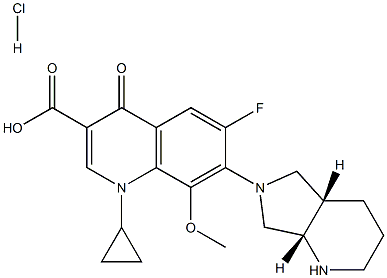
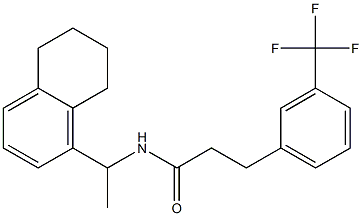
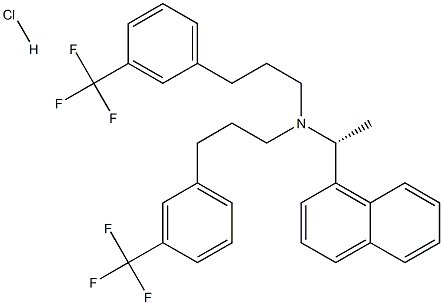
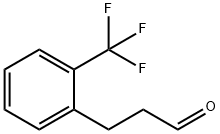

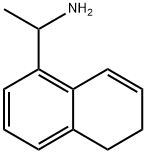
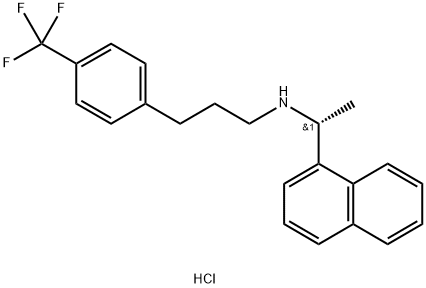
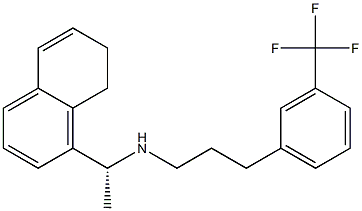
You may like
-
 364782-34-3 Cinacalcet hydrochloride 98%View Details
364782-34-3 Cinacalcet hydrochloride 98%View Details
364782-34-3 -
 364782-34-3 98%View Details
364782-34-3 98%View Details
364782-34-3 -
 364782-34-3 98%View Details
364782-34-3 98%View Details
364782-34-3 -
 Cinacalcet Hcl 99%View Details
Cinacalcet Hcl 99%View Details -
 364782-34-3 95-99%View Details
364782-34-3 95-99%View Details
364782-34-3 -
 Cinacalcet hydrochloride 98% (HPLC) CAS 364782-34-3View Details
Cinacalcet hydrochloride 98% (HPLC) CAS 364782-34-3View Details
364782-34-3 -
 Cinacalcet CAS 364782-34-3View Details
Cinacalcet CAS 364782-34-3View Details
364782-34-3 -
 364782-34-3 98%View Details
364782-34-3 98%View Details
364782-34-3
